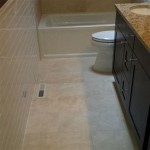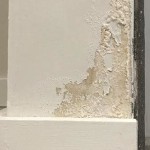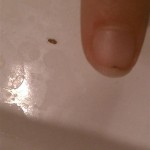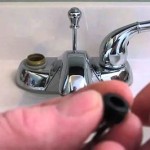Is It Safe To Drink Out Of the Bathroom Tap?
The question of whether it is safe to drink water from a bathroom tap is a common one, and the answer is nuanced. While the water originating from the bathroom tap is generally the same potable water that flows from the kitchen tap, several factors can influence its final quality. These factors include the plumbing system, the frequency of use, and the potential for contamination within the bathroom environment itself. A comprehensive understanding of these variables is crucial to making an informed decision about drinking water from a bathroom tap.
The primary source of water for both the bathroom and kitchen taps is typically the same municipal water supply. This water is treated to meet established safety standards set by regulatory agencies like the Environmental Protection Agency (EPA) in the United States. The treatment process usually involves filtration, disinfection (often with chlorine or chloramine), and testing for various contaminants to ensure it is safe for human consumption. However, the journey of the water from the treatment plant to the tap can introduce potential risks.
One of the most significant considerations is the plumbing system within the building. Older buildings often have lead pipes or lead solder connecting copper pipes. Lead can leach into the water, especially if the water is acidic or sits stagnant for an extended period. Even in newer buildings, brass faucets and fixtures can contain some lead, although regulations have significantly reduced the allowable lead content in these materials. Corrosion within the pipes can also release other metals, such as copper, into the water.
Another factor is the frequency of tap use. Infrequently used taps, such as those in guest bathrooms, can allow water to stagnate within the pipes. Stagnant water can harbor bacteria and other microorganisms, and it can also increase the concentration of lead or other contaminants that may leach from the plumbing. Running the tap for a minute or two can flush out stagnant water and bring in fresh water from the main supply, which may improve water quality.
The bathroom environment itself can also contribute to potential contamination. Bathrooms are often humid and contain various cleaning products, personal care items, and other potential sources of pollutants. While these substances are unlikely to directly contaminate the water supply within the pipes, there is a possibility of cross-contamination if proper hygiene practices are not followed. For example, if a contaminated object comes into contact with the tap or faucet, it could potentially transfer contaminants to the water stream. Furthermore, mold growth, which is common in bathrooms due to high humidity, could indirectly affect the water quality if spores are released into the air and settle on the tap.
Plumbing Materials and Lead Contamination
The materials used in plumbing systems are a critical factor in determining the safety of water from any tap, including the bathroom tap. Lead is a neurotoxin that can cause serious health problems, especially in children and pregnant women. Even low levels of lead exposure can lead to developmental issues, learning disabilities, and behavioral problems. Therefore, understanding the potential for lead contamination is paramount.
Prior to the Safe Drinking Water Act amendments in 1986, lead pipes were commonly used in residential plumbing. Even after the ban on lead pipes, lead solder was still used to join copper pipes. Over time, the lead in these materials can leach into the water, especially if the water is corrosive (i.e., acidic). The EPA has established a maximum contaminant level goal (MCLG) of zero for lead in drinking water, reflecting the fact that there is no safe level of lead exposure. The action level for lead is 15 parts per billion (ppb), and if lead levels exceed this action level in more than 10% of tested homes, water systems are required to take steps to reduce lead contamination.
To mitigate the risk of lead contamination, several strategies can be employed. First, it is important to identify whether lead pipes or lead solder are present in the plumbing system. This may require consulting with a qualified plumber or conducting a lead test of the water. If lead is present, the most effective solution is to replace the lead pipes or solder with lead-free alternatives. However, this can be a costly and disruptive undertaking.
Another approach is to flush the tap for a few minutes before using the water for drinking or cooking. This helps to remove any water that has been sitting in the pipes and may have accumulated lead. The duration of flushing depends on how long the water has been stagnant; if the tap has not been used for several hours, a longer flushing time is recommended. Cold water should always be used for drinking and cooking, as hot water is more likely to leach lead from the plumbing. The EPA also recommends cleaning faucet aerators regularly to remove any particulate matter that may have accumulated, including lead particles.
Water filters certified to remove lead can also be installed at the tap or at the main water line. These filters typically use activated carbon or other filtration media to remove lead and other contaminants. It is important to choose a filter that is certified by an independent organization, such as NSF International, to meet specific performance standards for lead reduction. Regular maintenance of the filter, including replacing the filter cartridge according to the manufacturer's instructions, is essential to ensure its continued effectiveness.
Stagnation and Microbial Growth
Water stagnation within the plumbing system provides an environment conducive to microbial growth. Bacteria, fungi, and other microorganisms can proliferate in stagnant water, potentially posing health risks. The warmer the water and the longer it sits stagnant, the greater the opportunity for microbial growth. This is particularly relevant for infrequently used taps, such as those in guest bathrooms or vacation homes.
One of the most concerning microorganisms that can grow in stagnant water is *Legionella* bacteria, which can cause Legionnaires' disease, a severe form of pneumonia. *Legionella* bacteria thrive in warm water environments, such as hot water tanks and plumbing systems. When contaminated water is aerosolized, for example, through showering or using a faucet with an aerator, the bacteria can be inhaled and cause infection. Symptoms of Legionnaires' disease include fever, cough, and shortness of breath.
Other types of bacteria, such as *Pseudomonas* and *Mycobacterium*, can also grow in stagnant water and cause infections, particularly in individuals with weakened immune systems. In addition, slime-forming bacteria can create biofilms on the inner surfaces of pipes, which can harbor pathogens and make it difficult to disinfect the plumbing system. These biofilms can also contribute to unpleasant tastes and odors in the water.
To prevent microbial growth in plumbing systems, regular use of all taps is recommended. Running the tap for a few minutes each day can help to flush out stagnant water and prevent the buildup of biofilms. Maintaining water heaters at a temperature of at least 140°F (60°C) can help to kill *Legionella* bacteria. However, to prevent scalding, especially in homes with young children or elderly residents, a thermostatic mixing valve can be installed to blend hot and cold water to a safe temperature at the tap.
Disinfecting the plumbing system may be necessary if microbial contamination is suspected. This can be done by flushing the system with a chlorine solution or hydrogen peroxide. It is important to follow the manufacturer's instructions carefully and to ensure that the disinfectant is thoroughly flushed out of the system before using the water for drinking or cooking. Professional plumbing services can also provide disinfection services and conduct testing to identify the type and extent of microbial contamination.
Bathroom-Specific Contamination Risks
While the water source for bathroom taps is generally the same as for kitchen taps, the bathroom environment presents unique contamination risks. Bathrooms are typically used for personal hygiene activities, such as washing hands, brushing teeth, and showering. These activities can introduce various contaminants into the bathroom environment, which may indirectly affect the water quality from the tap.
One potential source of contamination is the use of cleaning products. Bathrooms are often cleaned with harsh chemicals to disinfect surfaces and remove stains. These chemicals can leave residues on surfaces, including the tap and faucet. If these residues come into contact with the water stream, they could contaminate the water. It is important to rinse surfaces thoroughly after cleaning and to avoid spraying cleaning products directly onto the tap or faucet.
Personal care products, such as soaps, shampoos, and lotions, can also contribute to contamination. These products often contain fragrances, preservatives, and other chemicals that can be harmful if ingested. If these products are spilled or sprayed onto the tap or faucet, they could potentially contaminate the water. It is important to store personal care products properly and to clean up any spills promptly.
Another consideration is the potential for backflow, which is the reverse flow of water from a contaminated source into the potable water supply. Backflow can occur if there is a drop in water pressure in the main water line. For example, if a toilet is flushed while a hose is connected to the tap, the water in the hose could be drawn back into the potable water supply. To prevent backflow, backflow preventers should be installed on all taps that are connected to hoses or other potential sources of contamination.
The cleanliness of the tap and faucet is also important. Regularly cleaning the tap and faucet with soap and water can help to remove dirt, grime, and other contaminants that may have accumulated. Special attention should be paid to the aerator, which can trap debris and harbor bacteria. The aerator should be removed and cleaned periodically to maintain water quality.
In summary, while the water from the bathroom tap originates from the same source as the kitchen tap, several factors can influence its final quality. Plumbing materials, stagnation, and bathroom-specific contamination risks all need to be considered. By understanding these factors and taking appropriate precautions, individuals can make informed decisions about whether it is safe to drink water from the bathroom tap. Regular maintenance of the plumbing system, proper hygiene practices, and the use of water filters can help to ensure that the water is safe and potable.

Is It Safe To Drink Water From Your Bathroom Tap
People Are Only Just Discovering Why You Shouldn T Drink Water From The Bathroom Tap

Is It Safe To Drink Water From The Bathroom Tap Glasgow Live

Is Bathroom Sink Water Safe To Drink

Is It Safe To Drink Bathroom Sink Water

Is Bathroom Sink Water Safe To Drink Find Out Now Upgradedhome Com
Do People Actually Drink Water Straight From The Tap Quora

The Health Risks Of Drinking From Your Bathroom Tap Total Soft Water

Is Bathroom Water Safe To Drink Victoriaplum Com

People Discover Real Reason Your Mother Always Warned You Not To Drink From Bathroom Tap And It S Revolting Irish Mirror
Related Posts







